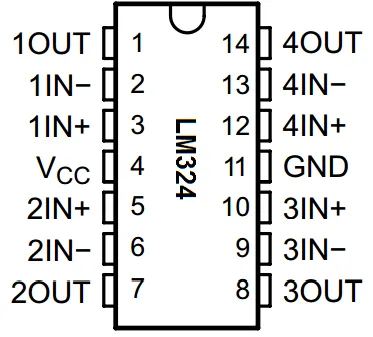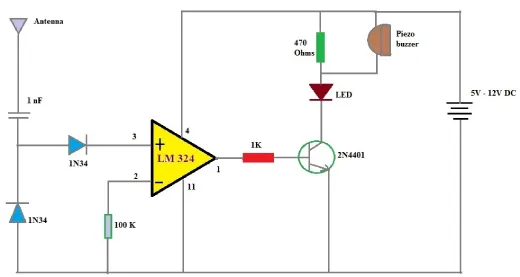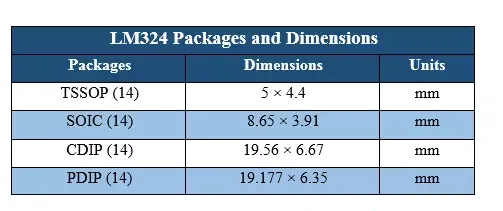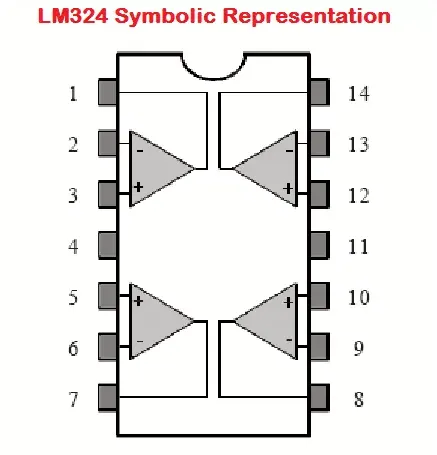What is an LM324 IC Comparator?
Greetings, everyone! I trust you're all doing well and enjoying yourselves. Today, I'll be diving into an exploration of the LM324. This Operational Amplifier (Op-amp) is equipped with four channels and is renowned for its cost-effectiveness and true differential inputs. Particularly suited for single-supply applications, the LM324 excels compared to other op-amps. It operates efficiently within a voltage range from as low as 3V to as high as 32V, offering versatility in various scenarios. An outstanding feature of the LM324 is its common mode input range, which encompasses the negative supply, eliminating the need for external biasing. Furthermore, the output voltage range includes negative power supply voltage. This device is lead (Pb) free, halogen free, and complies with RoHS standards. With four amplifiers packed into a single package, the LM324 finds application in a multitude of scenarios, including conventional amplifier circuits, transducer amplifiers, DC gain blocks, and more. In the forthcoming sections of this tutorial, we'll delve deeper into the LM324, exploring its pin configuration, thermal and electrical characteristics, features, and applications in greater detail.
LM324 Overview
The LM324 is a quad operational amplifier featuring four channels. Renowned for its cost-effectiveness, it stands as one of the most widely used amplifiers in various applications. With four amplifiers housed in a single package, it offers superior performance in single-supply applications compared to other amplifiers. The inclusion of negative power supply in both the common mode input and output range negates the necessity for external biasing. Its versatility extends to diverse applications such as DC gain blocks, transducer amplifiers, and conventional amplifier circuits. The LM324 is depicted in the figure below.
LM324 Pin Configuration
Before utilizing any device, it's essential to understand the function of each pin to ensure proper operation. The LM324 features a total of fourteen (14) pins, each serving a distinct purpose.
The table below presents all fourteen pins in sequential order along with their corresponding names and functions.

LM324 IC based Cell phone Detector Circuit Diagram
The diagram below illustrates a cell phone detector circuit based on the LM324 IC. This circuit is designed to detect cell phones from a distance of 10 to 20 meters. The detection range may vary depending on the signal strength of the mobile phone, as each device has its own signal transmission capability. It's important to note that this circuit only detects encoded signals and does not intercept voice content. Encoded signals are typically generated when a cell phone receives or makes calls, as well as when sending or receiving SMS messages. The versatility of this circuit allows for various applications, such as locating a lost phone or identifying cell phones in restricted areas.

The construction of this circuit is straightforward, utilizing commonly available electrical and electronic components. At its core lies the LM324 operational amplifier, which boasts four high-gain operational amplifiers. However, in this application, only a single op-amp from the four available is utilized.
A 2N4401 transistor is employed at the output of the LM324 to control the activation of both the LED and piezo buzzer. Furthermore, the number of LEDs in the circuit can be expanded to as many as 25.
This circuit operates within a range of 4.5 to 12 volts DC. If operated below 9 volts (lower voltage), the value of the current-limiting resistor for all LEDs in the circuit must be adjusted from 470 ohms to 220 ohms.
Additionally, the sensitivity of the circuit can be adjusted using a 100K variable resistor.
LM324 Package Variants
The LM324 is available in four distinct package types, each with its own unique dimensions. These packages are:
1. Thin Shrink Small Outline Package (TSSOP)
2. Small Outline Integrated Circuit (SOIC)
3. Ceramic Dual In-line Package (CDIP)
4. Plastic Dual In-line Package (PDIP)
Detailed dimensions for each package variant are provided in the table below.

LM324 IC Ratings
The LM324 integrated circuit (IC) possesses specific voltage, current, and power ratings that delineate its power requirements and operational limits. These ratings include:
1. Input Voltage Range: The input voltage range of the LM324 spans from -0.3 to 32 volts, allowing for versatile input signal handling.
2. Differential Input Voltage: The LM324 can withstand a differential input voltage of up to 32 volts, facilitating robust performance in various applications.
3. Input Current: With an input current rating of 50 mA, the LM324 ensures efficient signal processing and minimal current draw.
4. Power Dissipation: The LM324 has a power dissipation rating of 1130 mW, indicating the maximum power it can dissipate without overheating.
5. Storage Temperature: Operating within a wide temperature range, the LM324 can endure storage temperatures ranging from -65 to 150 degrees Celsius, ensuring reliability across different environmental conditions.
6. Supply Voltage: The LM324 operates within a supply voltage range of up to 32 volts, providing flexibility in power supply configurations.
These ratings offer valuable insights into the LM324's capabilities and limitations, guiding its proper usage in electronic circuits and systems.

LM324 Schematic Diagram
A schematic diagram elucidates the internal functionality of a device, aiding in comprehension of its operation. Below is the schematic diagram of the LM324, depicting its internal circuitry and connections.

Observing the diagram provided above, it's evident that the LM324 comprises four amplifiers within a single package. The inputs of these amplifiers are linked to pins 2, 3, 5, 6, 9, 10, 12, and 13, while their outputs are connected to pins 1, 7, 8, and 14 respectively.
LM324 IC Applications
The LM324 integrated circuit (IC) boasts a wide array of applications, including:
1. Line Following Robots: It is commonly utilized as a comparator in line-following robots, aiding in navigation and control.
2. Conventional Op-Amp Applications: The LM324 facilitates the implementation of traditional operational amplifier (op-amp) applications with ease and simplicity.
3. Versatile Functions: It can be employed in various functions such as oscillators, rectifiers, amplifiers, and comparators, showcasing its versatility and adaptability across different electronic circuits and systems.
LM324 Proteus Simulation
I've incorporated the LM324 operational amplifier into an Automatic Street Light Project simulation within Proteus. Additionally, I've developed a dedicated LM324 Proteus Simulation to provide a clearer understanding of its functionality.
In this simulation, I've designed a straightforward circuit where an LED toggles between ON and OFF states automatically based on the Light Dependent Resistor (LDR) value. Below is an illustration of its OFF state:
LM324 IC Features
The LM324 integrated circuit offers a host of features, including:
1. Frequency Compensation: Unity gain is internally compensated within the IC, enhancing stability and performance.
2. Large DC Voltage Gain: With a substantial gain of 100 dB, the LM324 ensures efficient signal amplification.
3. Wide Bandwidth: Operating with a wide bandwidth of 1 MHz, it facilitates the amplification of a broad range of frequencies.
4. Wide Power Supply Range: Compatible with a broad range of power supply voltages, from 3 volts to 32 volts for single voltage supplies, ensuring versatility in various applications.
5. Supply Voltage Independence: The LM324 exhibits basic independence from supply voltage variations, enhancing reliability and consistency.
6. Differential Input Voltage Range: The range of differential input voltage spans from the negative to positive power supply voltages, allowing for flexible input signal handling.
7. Output Voltage Swing: With an output voltage swing ranging from 0V to V+ and -1.5V, the LM324 accommodates a wide range of output voltage levels, ensuring compatibility with diverse loads and circuit configurations.
In summary
The LM324 IC offers several advantages and unique characteristics:
1. Dual Functionality: The LM324 serves as both an operational amplifier and a comparator, providing versatility in various electronic applications.
2. Electronic Voltage Amplification: It acts as an electronic voltage amplifier with high-gain capabilities, making it suitable for amplifying weak signals.
3. Wide Usage Range: The LM324 is widely used in different electronic circuits and systems due to its dual functionality and reliability.
If you have any doubts or need further technical information, feel free to comment below. Now, here's a question for you: What are some common applications of the LM324 IC in electronic circuits?
ESP32 vs Arduino:An In-Depth Contrast
Fiber Modems: Types, Advantages & Applications
Servo Motor vs. Stepper Motor: Key Differences Explained
NRF24L01 Module:Pinout ,Features& Principle
What are Media Converter? Functions and Applications
Automotive Relays: Types, Advantages & Applications
Human-Machine Interface(HMI) Technology [Explained]
What is Flash Memory? [Comprehensive Guide]
The Transmission System and Its Function
NPN VS PNP BJT Transistor: Common Knowledge










